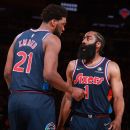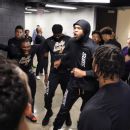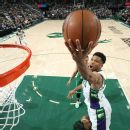NBA playoffs 2022: James Harden’s performance reveals the uncertain future for the Philadelphia 76ers’ star duo
76ers #76ers

IN EARLY MARCH, sitting on-stage inside Boston’s Hynes Convention Center for the start of the annual MIT Sloan Sports Analytics Conference, Daryl Morey wore a blue blazer over a red shirt that featured a cartoon of James Harden’s face from his famous internet meme.
“Besides ‘Seize The Data,’ the theme of this conference is reuniting,” said Morey, the Philadelphia 76ers president of basketball operations who co-founded the stats symposium nearly 20 years ago.
“I was lucky enough to get reunited with my basketball Jesus.”
Across Morey’s career as an executive, he has come to be defined by two things on the court: helping popularize the use of analytics across the NBA, and his eight-year partnership with Harden and the Houston Rockets.
A month earlier, Morey had completed his year-long odyssey to reunite with his former MVP, a journey Morey punctuated with a picture from a tarmac next to a private jet upon Harden’s arrival.
The caption: a single trophy emoji.
“Our mission that’s been given to us, [it’s] the whole reason that everyone on the team is really here,” Morey said at Harden’s introductory news conference a few days later. “[General manager Elton Brand is] here to win a title. [Coach Doc Rivers] is here to win a title.
“It’s unfinished business for all of us. … We knew, from the moment Ben [Simmons] asked out, that if we were gonna do a trade, it had to be for [a player] we thought could allow us to compete at a high level.
“And, the way this league works, you have to get players of the caliber of a James Harden to pair with a Joel Embiid and Tobias [Harris]. You can’t win without it.”

1hBobby Marks

13hDave McMenamin

1h
2 Related
Morey’s thinking was also an assumption: that Harden was still the level of player that finished first or second in MVP voting four out of five seasons during their time together in Houston.
But it’s become clear that the MVP-level version of Harden is gone.
He certainly didn’t show up in the biggest game of Philadelphia’s season. With everything on the line in Game 6 of their Eastern Conference semifinal against the Miami Heat, Harden was a non-factor. He finished with 11 points, 9 assists and 4 turnovers. His giveaway with just under 11 minutes remaining in the fourth quarter — which led to Bam Adebayo’s fast break bucket — sent boos raining down from the sellout crowd inside Wells Fargo Center as Harden and his teammates trudged back to the bench.
Miami eventually ended Philadelphia’s postseason with a 99-90 win, sending the 76ers crashing out of the second round for the fourth time in five seasons.
Now the franchise heads into another offseason full of uncertainty with another massive — and potentially expensive — question.
Is there a future for Harden and the 76ers?
“This is their bed,” said a Western Conference executive. “They’re making it, they’re gonna sleep in it and it’s not gonna f—ing work.”
THE HARDEN-EMBIID partnership should make sense.
Harden has spent the past decade being an elite NBA offense unto himself. From the 2013-14 season — the first season Second Spectrum began tracking data — through 2019-20, Harden recorded nearly 8,000 isolation plays, more than 2,000 more than any other player during that span.
He averaged 1.10 points on those plays, the highest efficiency in the league. He made 734 step-back 3-pointers during that span, over 500 more than any other player.
The plan: Pairing Harden with Embiid, arguably the league’s most dominant physical force, another of its elite foul-drawers and a finalist for the NBA’s Most Valuable Player award for a second straight season, would create an offensive juggernaut.
Early on, the returns were good. Harden had at least 25 points on at least 50% shooting in each of his first four games as a 76er — all wins.
After toppling the New York Knicks in the duo’s second game together — during which Harden and Embiid combined to shoot 37 free throws — the big man offered up a simple review:
“Unstoppable,” Embiid said with a smile.
Those early performances proved to be outliers. Over Harden’s final 29 games of this season — including Philadelphia’s 12 postseason contests — he managed to hit those benchmarks four more times each — and only had one game, against the Milwaukee Bucks on March 29, when he hit them both on the same night.
The first postseason of the Joel Embiid-James Harden partnership delivered a second-round exit. Getty Images
The underrated part of Harden’s peak was his athleticism and burst, a combination that allowed him to both get to the basket at will and turn his stepback jumper into one of the most unguardable shots in NBA history.
But recurring hamstring injuries over the past two seasons have zapped that burst. In 2019-20, per Second Spectrum, Harden blew by his defender on 44.1% of his drives. That percentage dropped to 30.3% last season and to 29.1% this season.
Harden’s offensive efficiency has taken a dive. His effective field goal percentage dropped below 50% for the first time since his rookie year. Among 71 players who attempted at least 300 layups and dunks this season, per Second Spectrum, only two — Harden and the Knicks’ RJ Barrett — shot less than 50% on them.
Those issues came to the fore during the playoffs. Against two long, athletic defenses — the Toronto Raptors in the first round and the Heat in the conference semifinals — Harden had a series of pedestrian performances with the occasional moment of brilliance dropped in.
Harden shot 44.2% in the paint this postseason, per Second Spectrum, his lowest number in any playoffs in which he’s played multiple rounds. He made 32 field goals and committed 29 turnovers against Miami, and his 0.88 points per chance on drives against the Heat, per Second Spectrum, was his lowest number since 2014.
Harden scored over 30 points once in the postseason — in Philadelphia’s Game 4 home victory over Miami — and consistently struggled to finish inside. His 40.4% shooting overall and 43.8% on 2-point shots were his lowest marks in the postseason in eight years. And he posted the highest turnover rate of his career while having a far lower usage rate than in any of his prolific Houston seasons.

Thursday, May 12Heat at 76ers, Game 6 (7 p.m.)Suns at Mavs, Game 6 (9:30 p.m.)
Friday, May 13Celtics at Bucks, Game 6Grizzlies at Warriors, Game 6*
*If necessary | All times Eastern
76ers coach Doc Rivers and Harden’s teammates repeatedly tried to readjust expectations as the playoffs went on. Harden still is an elite playmaker and the only pure point guard on Philadelphia’s roster.
And even Harden has alluded to his game morphing away from the one-man show and to more of a facilitating role.
“I’ve always been the communicator, the organizer, trying to get guys in the right positions,” Harden said after Game 3. “I think [that’s the case] more now than ever.”
When Philadelphia has played well offensively in these playoffs, Harden has been a driving force. When he’s on the court, the 76ers offense clocks in at 114.7 points per 100 possessions — which would sit comfortably among the top five in the league during the regular season.
When he goes to the bench, Philadelphia’s offensive rating plummets to 101.5, which would easily be the NBA’s lowest.
The Sixers were without Embiid in Games 1 and 2 against Miami, but both were winnable due to middling performances by the Heat, who were without Kyle Lowry. But Harden shot just 11-for-28 from the field, including 3-for-12 from 3-point range.
“It’s not about James,” 76ers coach Doc Rivers said after Philly’s Game 1 loss.”It’s about all of them. We’re a team, and we have to play better as a team. “It’s not one guy who’s going to take up slack from not having Joel.”
The reasoning behind trading for Harden, however, was to have exactly that.
Now, Harden’s 2022 playoffs underlie how complicated his potential free agency will be to navigate — for all sides involved.
IN TRADING FOR Harden, Morey and the 76ers were expecting their season to end in a different place than it did last year. Instead, it wound up delivering the same result — just with different problems along the way.
Last year, Philadelphia’s postseason ended with its All-Star point guard passing up an open dunk in the closing moments of Game 7 of the Eastern Conference semifinals at home against a lower-seeded team.
This year, Philadelphia’s postseason ended with its All-Star point guard going 4-for-9 as Philadelphia lost in Game 6 on its home court to a Miami team missing Lowry for the fourth time in six games of the series.
There are mitigating circumstances — most notably Embiid’s injuries. This loss, however, is about Harden. He was, by Morey’s own admission, the final piece to the puzzle, the move that had to work.
“This is literally our way to pair Joel with Tobias and another impact player to give ourselves a real chance to win,” Morey said in a radio interview two weeks before acquiring Harden at the deadline, explaining the importance of nailing any Simmons trade.
“And if we just do a marginal trade that’s mostly sideways because we’ll all feel better that there are names playing on the court, that will hurt Joel, that will hurt the 76ers, that will hurt our whole roster in the long run more than if we’re patient.”
Philadelphia finds itself in danger of getting hurt again this summer.
Why? Because of Harden’s uncertain contract situation.
James Harden, Joel Embiid and Tyrese Maxey could be one of the East’s better big threes next season. Matt Slocum/AP Photo
When the Harden-Simmons swap was completed, Harden was expected to opt-in to the final year of his contract, giving Philadelphia a level of protection. Harden, however, did not — and he gave some rather circumspect answers in February when asked why.
“Everything happened so fast,” Harden said. “I just wanted to get here and take my time and most importantly focus on the end game, and that’s winning a championship.”
Harden began this season expecting to get a new max contract this summer. In recent years, veteran point guards like Lowry, Chris Paul and Mike Conley have extended for somewhere between $25 and $30 million a season — far below Harden’s option year of $47 million, and well below the $270 million he could command over five years if he turns down that option and becomes a free agent.
And while the 37-year-old Paul had another brilliant season for Phoenix, Harden is seen by executives as more fitting of being compared to those types of veteran, steadying presences than to players worthy of max money.
“I’ll be here,” Harden said of Philly after Game 6. “Whatever allows us to continue to grow and get better and do the things necessary to win and compete at a high level.”
Harden could also attempt to find that money elsewhere, there are only a few teams — most are rebuilding without the use of a pricey guard who will turn 33 in August — with cap space this summer. For those same reasons, the idea of paying Harden a full max contract should give any team pause, including the 76ers.
“Would he go along with a little less? I don’t know,” said an Eastern Conference scout. “If there were any logic whatsoever, the answer [to giving him a max deal] would be no.”

Compete for $40,000 throughout the NBA postseason! Make Your Picks
Harden’s career is littered with postseason disappointments. He disappeared in Game 6 in the 2017 Western Conference semifinals, going 2-for-11 as the Rockets were routed by the San Antonio Spurs on their home court while Kawhi Leonard watched in street clothes. Harden and the rest of the Rockets missed 27 straight 3-pointers in Game 7 against the Golden State Warriors in the 2018 West finals, then flamed out against an injury-depleted Warriors team the following season.
He’s clashed with several star teammates, from Dwight Howard to Chris Paul to Russell Westbrook to Kevin Durant and Irving.
His arrival in Philadelphia, though, was a chance to change the narrative. And for a city that grew exhausted of the Simmons saga, simply being able to have Harden on the court was enough to earn him plenty of goodwill.
But then came another failed playoff run for this franchise, one that culminated with Harden’s disappearing act in an elimination game. In the second half of Game 6, Harden was engaged, taking and missing just two shots and finishing with nine for the game.
“We ran our offense,” Harden said postgame. “The ball just didn’t get back to me.”
Rivers called timeout to pull his starters with 68 seconds remaining after one final bucket by Jimmy Butler, the clock running out on the 76ers’ season as fans still scattered around the bowl of the arena offered a final hearty round of boos.
“I’m in a place where I can be the best James Harden I can be on the court,” Harden said at his introductory press conference.
The problem, for both Harden and the 76ers, is that his best these days isn’t what it used to be. Now, three months after they were brought together in what seemed like a perfect long-term union, the future for both sides couldn’t be murkier.